Process Optimization and Biomethane Recovery from Anaerobic Digestion of Agro-Industry Wastes
Abstract
:1. Introduction
2. Materials and Methods
2.1. Substrate and Inoculum
2.2. BMP Assays
2.3. Effluent Evaluation
2.4. Theoretical Maximum Methane Yield
2.5. Biodegradability
2.6. Modeling Methane Production Kinetics
2.7. Data Analysis
3. Result
3.1. Properties of Goat Manure, Cotton Gin Trash, Food Waste, and Sorghum
3.2. Daily and Cumulative Biomethane Production and Biodegradabilities
3.3. Modeling Biomethane Production
3.4. Effluent Evaluation as Biofertilzers
4. Conclusions
Author Contributions
Funding
Conflicts of Interest
References
- GCP—Carbon Budget. Available online: https://www.globalcarbonproject.org/carbonbudget/ (accessed on 1 September 2023).
- Maasakkers, J.D.; Varon, D.J.; Elfarsdóttir, A.; McKeever, J.; Jervis, D.; Mahapatra, G.; Pandey, S.; Lorente, A.; Borsdorff, T.; Foorthuis, L.R.; et al. Using satellites to uncover large methane emissions from landfills. Sci. Adv. 2022, 8, 9683. [Google Scholar] [CrossRef] [PubMed]
- USEPA. From Farm to Kitchen: The Environmental Impacts of U.S. Food Waste. 2021. Available online: https://www.epa.gov/system/files/documents/2021-11/from-farm-to-kitchen-the-environmental-impacts-of-u.s.-food-waste_508-tagged.pdf (accessed on 8 May 2023).
- Raj, T.; Chandrasekhar, K.; Morya, R.; Kumar Pandey, A.; Jung, J.H.; Kumar, D.; Singhania, R.R.; Kim, S.H. Critical challenges and technological breakthroughs in food waste hydrolysis and detoxification for fuels and chemicals production. Bioresour. Technol. 2022, 360, 127512. [Google Scholar] [CrossRef] [PubMed]
- Shanmugam, S.; Sekar, M.; Sivaramakrishnan, R.; Raj, T.; Ong, E.S.; Rabbani, A.H.; Rene, E.R.; Mathimani, T.; Brindhadevi, K.; Pugazhendhi, A. Pretreatment of second and third generation feedstock for enhanced biohythane production: Challenges, recent trends and perspectives. Int. J. Hydrogen Energy 2021, 46, 11252–11268. [Google Scholar] [CrossRef]
- Meegoda, J.N.; Li, B.; Patel, K.; Wang, L.B. A review of the processes, parameters, and optimization of anaerobic digestion. Int. J. Environ. Res. Public Health 2018, 15, 2224. [Google Scholar] [CrossRef]
- Husain, A. Mathematical models of the kinetics of anaerobic digestion—A selected review. Biomass Bioenergy 1998, 14, 561–571. [Google Scholar] [CrossRef]
- Raposo, F.; Fernández-Cegrí, V.; De la Rubia, M.A.; Borja, R.; Béline, F.; Cavinato, C.; Demirer, G.; Fernández, B.; Fernández-Polanco, M.; Frigon, J.C.; et al. Biochemical methane potential (BMP) of solid organic substrates: Evaluation of anaerobic biodegradability using data from an international interlaboratory study. J. Chem. Technol. Biotechnol. 2011, 86, 1088–1098. [Google Scholar] [CrossRef]
- Akobi, C.; Yeo, H.; Hafez, H.; Nakhla, G. Single-stage and two-stage anaerobic digestion of extruded lignocellulosic biomass. Appl. Energy 2016, 184, 548–559. [Google Scholar] [CrossRef]
- Krakat, N.; Demirel, B.; Anjum, R.; Dietz, D. Methods of ammonia removal in anaerobic digestion: A review. Water Sci. Technol. 2017, 76, 1925–1938. [Google Scholar] [CrossRef]
- Holl, E.; Steinbrenner, J.; Merkle, W.; Krümpel, J.; Lansing, S.; Baier, U.; Oechsner, H.; Lemmer, A. Two-stage anaerobic digestion: State of technology and perspective roles in future energy systems. Bioresour. Technol. 2022, 360, 127633. [Google Scholar] [CrossRef]
- Srisowmeya, G.; Chakravarthy, M.; Nandhini Devi, G. Critical considerations in two-stage anaerobic digestion of food waste—A review. Renew. Sustain. Energy Rev. 2020, 119, 109587. [Google Scholar] [CrossRef]
- Pasteris, A.M.; Heiermann, M.; Theuerl, S.; Plogsties, V.; Jost, C.; Prochnow, A.; Herrmann, C. Multi-advantageous sorghum as feedstock for biogas production: A comparison between single-stage and two-stage anaerobic digestion systems. J. Clean. Prod. 2022, 358, 131985. [Google Scholar] [CrossRef]
- Zielonka, S.; Lemmer, A.; Oechsner, H.; Jungbluth, T. Energy balance of a two-phase anaerobic digestion process for energy crops. Eng. Life Sci. 2010, 10, 515–519. [Google Scholar] [CrossRef]
- Wi, J.; Lee, S.; Ahn, H. Influence of Dairy Manure as Inoculum Source on Anaerobic Digestion of Swine Manure. Bioengineering 2023, 10, 432. [Google Scholar] [CrossRef]
- Kafle, G.K.; Chen, L. Comparison on batch anaerobic digestion of five different livestock manures and prediction of biochemical methane potential (BMP) using different statistical models. Waste Manag. 2016, 48, 492–502. [Google Scholar] [CrossRef] [PubMed]
- Kaur, H.; Kommalapati, R.R. Optimizing anaerobic co-digestion of goat manure and cotton gin trash using biochemical methane potential (BMP) test and mathematical modeling. SN Appl. Sci. 2021, 3, 724. [Google Scholar] [CrossRef]
- Rajendran, K.; Aslanzadeh, S.; Taherzadeh, M.J. Household Biogas Digesters—A Review. Energies 2012, 5, 2911–2942. [Google Scholar] [CrossRef]
- Weiland, P. Biogas production: Current state and perspectives. Appl. Microbiol. Biotechnol. 2009, 85, 849–860. [Google Scholar] [CrossRef] [PubMed]
- Wu, L.J.; Kobayashi, T.; Li, Y.Y.; Xu, K.Q. Comparison of single-stage and temperature-phased two-stage anaerobic digestion of oily food waste. Energy Convers. Manag. 2015, 106, 1174–1182. [Google Scholar] [CrossRef]
- Triolo, J.M.; Sommer, S.G.; Møller, H.B.; Weisbjerg, M.R.; Jiang, X.Y. A new algorithm to characterize biodegradability of biomass during anaerobic digestion: Influence of lignin concentration on methane production potential. Bioresour. Technol. 2011, 102, 9395–9402. [Google Scholar] [CrossRef]
- Regassa, T.H.; Wortmann, C.S. Sweet sorghum as a bioenergy crop: Literature review. Biomass Bioenergy 2014, 64, 348–355. [Google Scholar] [CrossRef]
- Garuti, M.; Mantovi, P.; Soldano, M.; Immovilli, A.; Ruozzi, F.; Fermoso, F.G.; Rodriguez, A.J.; Fabbri, C. Towards sustainable energy-crop cultivation: Feasibility of biomethane production using a double-cropping system with various sorghum phenotypes. Biofuels Bioprod. Biorefin. 2020, 14, 553–565. [Google Scholar] [CrossRef]
- Dareioti, M.A.; Kornaros, M. Anaerobic mesophilic co-digestion of ensiled sorghum, cheese whey and liquid cow manure in a two-stage CSTR system: Effect of hydraulic retention time. Bioresour. Technol. 2015, 175, 553–562. [Google Scholar] [CrossRef] [PubMed]
- Agblevor, F.A.; Cundiff, J.S.; Mingle, C.; Li, W. Storage and characterization of cotton gin waste for ethanol production. Resour. Conserv. Recycl. 2006, 46, 198–216. [Google Scholar] [CrossRef]
- Dalke, R.; Demro, D.; Khalid, Y.; Wu, H.; Urgun-Demirtas, M. Current status of anaerobic digestion of food waste in the United States. Renew. Sustain. Energy Rev. 2021, 151, 111554. [Google Scholar] [CrossRef]
- Lauzurique, Y.; Montalvo, S.; Salazar, R.; García, V.; Huiliñir, C. Fly ash from coal combustion as improver of anaerobic digestion: A review. J. Environ. Chem. Eng. 2021, 9, 106422. [Google Scholar] [CrossRef]
- Naresh Kumar, A.; Sarkar, O.; Chandrasekhar, K.; Raj, T.; Narisetty, V.; Mohan, S.V.; Pandey, A.; Varjani, S.; Kumar, S.; Sharma, P.; et al. Upgrading the value of anaerobic fermentation via renewable chemicals production: A sustainable integration for circular bioeconomy. Sci. Total Environ. 2022, 806, 150312. [Google Scholar] [CrossRef]
- Möller, K.; Müller, T. Effects of anaerobic digestion on digestate nutrient availability and crop growth: A review. Eng. Life Sci. 2012, 12, 242–257. [Google Scholar] [CrossRef]
- Campos, J.L.; Crutchik, D.; Franchi, Ó.; Pavissich, J.P.; Belmonte, M.; Pedrouso, A.; Mosquera-Corral, A.; Val del Río, Á. Nitrogen and Phosphorus Recovery from Anaerobically Pretreated Agro-Food Wastes: A Review. Front. Sustain. Food Syst. 2019, 2, 91. [Google Scholar] [CrossRef]
- Czekała, W.; Nowak, M.; Piechota, G. Sustainable management and recycling of anaerobic digestate solid fraction by composting: A review. Bioresour. Technol. 2023, 375, 128813. [Google Scholar] [CrossRef]
- Sanderman, J.; Hengl, T.; Fiske, G.J. Soil carbon debt of 12,000 years of human land use. Proc. Natl. Acad. Sci. USA 2017, 114, 9575–9580. [Google Scholar] [CrossRef]
- Badagliacca, G.; Petrovičovà, B.; Pathan, S.I.; Roccotelli, A.; Romeo, M.; Monti, M.; Gelsomino, A. Use of solid anaerobic digestate and no-tillage practice for restoring the fertility status of two Mediterranean orchard soils with contrasting properties. Agric. Ecosyst. Environ. 2020, 300, 107010. [Google Scholar] [CrossRef]
- Macias-Corral, M.; Samani, Z.; Hanson, A.; Smith, G.; Funk, P.; Yu, H.; Longworth, J. Anaerobic digestion of municipal solid waste and agricultural waste and the effect of co-digestion with dairy cow manure. Bioresour. Technol. 2008, 99, 8288–8293. [Google Scholar] [CrossRef]
- Hartmann, H.; Ahring, B.K. Anaerobic digestion of the organic fraction of municipal solid waste: Influence of co-digestion with manure. Water Res. 2005, 39, 1543–1552. [Google Scholar] [CrossRef] [PubMed]
- DOE Alternative Fuels Data Center: Energy Independence and Security Act of 2007. Available online: https://afdc.energy.gov/laws/eisa.html (accessed on 23 August 2023).
- FAO Goats|Livestock Systems|Food and Agriculture Organization of the United Nations. Available online: https://www.fao.org/livestock-systems/global-distributions/goats/en/ (accessed on 22 August 2023).
- APHA. Standard Methods for the Examination of Water and Wastewater, 20th ed.; American Public Health Association: Washington, DC, USA, 2005. [Google Scholar]
- Angelidaki, I.; Alves, M.; Bolzonella, D.; Borzacconi, L.; Campos, J.L.; Guwy, A.J.; Kalyuzhnyi, S.; Jenicek, P.; Van Lier, J.B. Defining the biomethane potential (BMP) of solid organic wastes and energy crops: A proposed protocol for batch assays. Water Sci. Technol. 2009, 59, 927–934. [Google Scholar] [CrossRef] [PubMed]
- Holliger, C.; Alves, M.; Andrade, D.; Angelidaki, I.; Astals, S.; Baier, U.; Bougrier, C.; Buffière, P.; Carballa, M.; De Wilde, V.; et al. Towards a standardization of biomethane potential tests. Water Sci. Technol. 2016, 74, 2515–2522. [Google Scholar] [CrossRef] [PubMed]
- Kaur, H.; Kommalapati, R.R. Biochemical Methane Potential and Kinetic Parameters of Goat Manure at Various Inoculum to Substrate Ratios. Sustainability 2021, 13, 12806. [Google Scholar] [CrossRef]
- Kaur, H.; Kommalapati, R.R. Effect of Inoculum Concentration and Pretreatment on Biomethane Recovery from Cotton Gin Trash. J. Agric. Sci. 2021, 13, 15. [Google Scholar] [CrossRef]
- Zhang, T.; Liu, L.; Song, Z.; Ren, G.; Feng, Y.; Han, X.; Yang, G. Biogas production by co-digestion of goat manure with three crop residues. PLoS ONE 2013, 8, e66845. [Google Scholar] [CrossRef]
- Hafner, S.D.; de Laclos, H.F.; Koch, K.; Holliger, C. Improving Inter-Laboratory Reproducibility in Measurement of Biochemical Methane Potential (BMP). Water 2020, 12, 1752. [Google Scholar] [CrossRef]
- Thomas, H.L.; Pot, D.; Latrille, E.; Trouche, G.; Bonnal, L.; Bastianelli, D.; Carrère, H. Sorghum Biomethane Potential Varies with the Genotype and the Cultivation Site. Waste Biomass Valoriz. 2019, 10, 783–788. [Google Scholar] [CrossRef]
- Orangun, A.; Kaur, H.; Kommalapati, R.R. Batch Anaerobic Co-Digestion and Biochemical Methane Potential Analysis of Goat Manure and Food Waste. Energies 2021, 14, 1952. [Google Scholar] [CrossRef]
- Tena, M.; Perez, M.; Fuel, R.S. Effect of hydraulic retention time on the methanogenic step of a two-stage anaerobic digestion system from sewage sludge and wine vinasse: Microbial and Kinetic Evaluation. Fuel 2021, 296, 120674. [Google Scholar] [CrossRef]
- Cataldi, T.R.I.; Margiotta, G.; Del Fiore, A.; Bufo, S.A. Ionic content in plant extracts determined by ion chromatography with conductivity detection. Phytochem. Anal. 2003, 14, 176–183. [Google Scholar] [CrossRef] [PubMed]
- Boyle, W.C. Energy Recovery from Sanitary Landfills—A Review; Pergamon Press: New York, NY, USA, 1977. [Google Scholar] [CrossRef]
- Buswell, A.M.; Mueller, H.F. Mechanism of methane fermentation. Ind. Eng. Chem. 1952, 44, 550–552. [Google Scholar] [CrossRef]
- Li, W.; Siddhu, M.A.H.; Amin, F.R.; He, Y.; Zhang, R.; Liu, G.; Chen, C. Methane production through anaerobic co-digestion of sheep dung and waste paper. Energy Convers. Manag. 2018, 156, 279–287. [Google Scholar] [CrossRef]
- Lay, J.-J.; Li, Y.-Y.; Noike, T. Effect of moisture content and chemical nature on methane fermentation characteristics of municipal solid wastes. Doboku Gakkai Ronbunshu 1996, 552, 101–108. [Google Scholar] [CrossRef]
- Lay, J.-J.; Li, Y.-Y.; Tatsuya, N. Influences of pH and moisture content on the methane production in high-solids sludge digestion. Water Res. 1997, 31, 1518–1524. [Google Scholar] [CrossRef]
- Richards, B.K.; Cummings, R.J.; White, T.E.; Jewell, W.J. Methods for kinetic analysis of methane fermentation in high solids biomass digesters. Biomass Bioenergy 1991, 1, 65–73. [Google Scholar] [CrossRef]
- Myllymäki, P.; Pesonen, J.; Romar, H.; Hu, T.; Tynjälä, P.; Lassi, U. The use of Ca-and Mg-rich fly ash as a chemical precipitant in the simultaneous removal of nitrogen and phosphorus—Recycling and reuse. Recycling 2019, 4, 14. [Google Scholar] [CrossRef]
- Siddiqui, Z.; Horan, N.J.; Anaman, K. Optimisation of C:N ratio for co-digested processed industrial food waste and sewage sludge using the BMP test. Int. J. Chem. React. Eng. 2011, 9, 1–9. [Google Scholar] [CrossRef]
- Raposo, F.; De La Rubia, M.A.; Fernández-Cegrí, V.; Borja, R. Anaerobic digestion of solid organic substrates in batch mode: An overview relating to methane yields and experimental procedures. Renew. Sustain. Energy Rev. 2012, 16, 861–877. [Google Scholar] [CrossRef]
- Moody, L.; Burns, R.; Wu-haan, W.; Spajic, R. Use of biochemical methane potential (BMP) assays for predicting and enhancing anaerobic digester performance. In Proceedings of the 44th Croatian and the 4th International Symposium on Agriculture, Opatija, Croatia, 16–20 February 2009. [Google Scholar]
- Lauzurique, Y.; Fermoso, F.G.; Sánchez, N.; Castillo, A.; Valdés, N.; Tello, M.; Salazar, R.; García, V.; Huiliñir, C. Effect of the addition of fly ash on the specific methane production and microbial communities in the anaerobic digestion of real winery wastewater. J. Chem. Technol. Biotechnol. 2021, 96, 2882–2890. [Google Scholar] [CrossRef]
- Maharaj, B.C.; Mattei, M.R.; Frunzo, L.; van Hullebusch, E.D.; Esposito, G. ADM1 based mathematical model of trace element precipitation/dissolution in anaerobic digestion processes. Bioresour. Technol. 2018, 267, 666–676. [Google Scholar] [CrossRef] [PubMed]
- Kugelman, J.I.; Perry, L.M. Cation toxicity and stimulation in anaerobic waste treatment. Water Pollut. Control Fed. 1965, 37, 97–116. [Google Scholar]
- Nabaterega, R.; Kumar, V.; Khoei, S.; Eskicioglu, C. A review on two-stage anaerobic digestion options for optimizing municipal wastewater sludge treatment process. J. Environ. Chem. Eng. 2021, 9, 105502. [Google Scholar] [CrossRef]
- Wang, Q.; Liang, Y.; Zhao, P.; Li, Q.X.; Guo, S.; Chen, C. Potential and optimization of two-phase anaerobic digestion of oil refinery waste activated sludge and microbial community study. Sci. Rep. 2016, 6, 38245. [Google Scholar] [CrossRef]
- Noah, S.B.; Jacob, H.; Pinto, R.; Lurie, S. Cell Wall Changes and Partial Prevention of Fruit Softening in Prestorage Heat Treated ‘Anna’ Apples. J. Sci. Food Agric. 1996, 72, 231–234. [Google Scholar]
- Li, X.; Li, L.; Zheng, M.; Fu, G.; Lar, J.S. Anaerobic co-digestion of cattle manure with corn stover pretreated by sodium hydroxide for efficient biogas production. Energy Fuels 2009, 23, 4635–4639. [Google Scholar] [CrossRef]
- Zhang, Z.; Li, B.; Briechle, M.G.; Wicaksana, F.; Yu, W.; Young, B. Effect of acetic acid on struvite precipitation: An exploration of product purity, morphology and reaction kinetics using central composite design. Chemosphere 2021, 285, 131486. [Google Scholar] [CrossRef]
- Wang, L.; Rinklebe, J.; Tack, F.M.G.; Hou, D. A review of green remediation strategies for heavy metal contaminated soil. Soil Use Manag. 2021, 37, 936–963. [Google Scholar] [CrossRef]
- Nkoa, R. Agricultural benefits and environmental risks of soil fertilization with anaerobic digestates: A review. Agron. Sustain. Dev. 2014, 34, 473–492. [Google Scholar] [CrossRef]
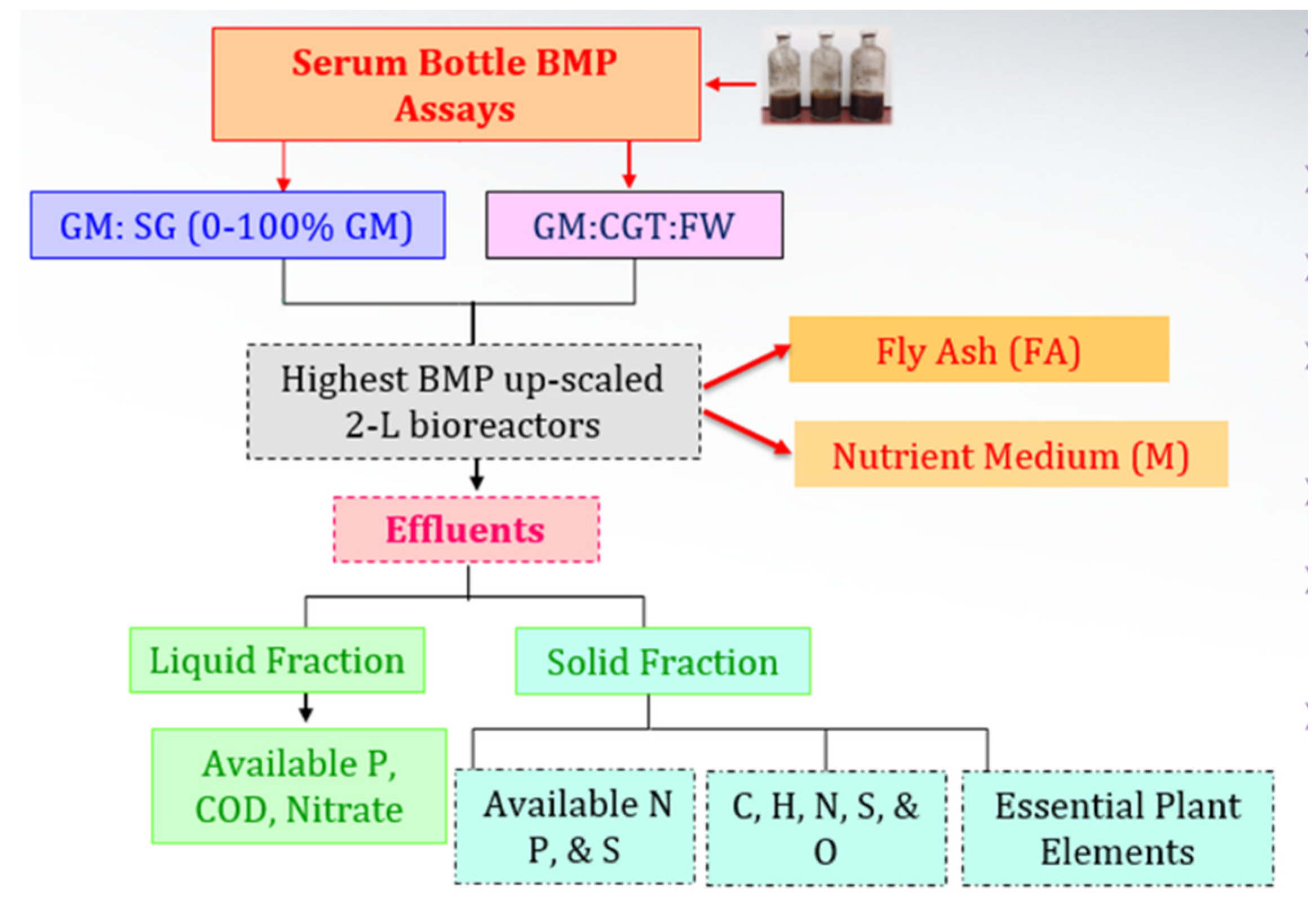

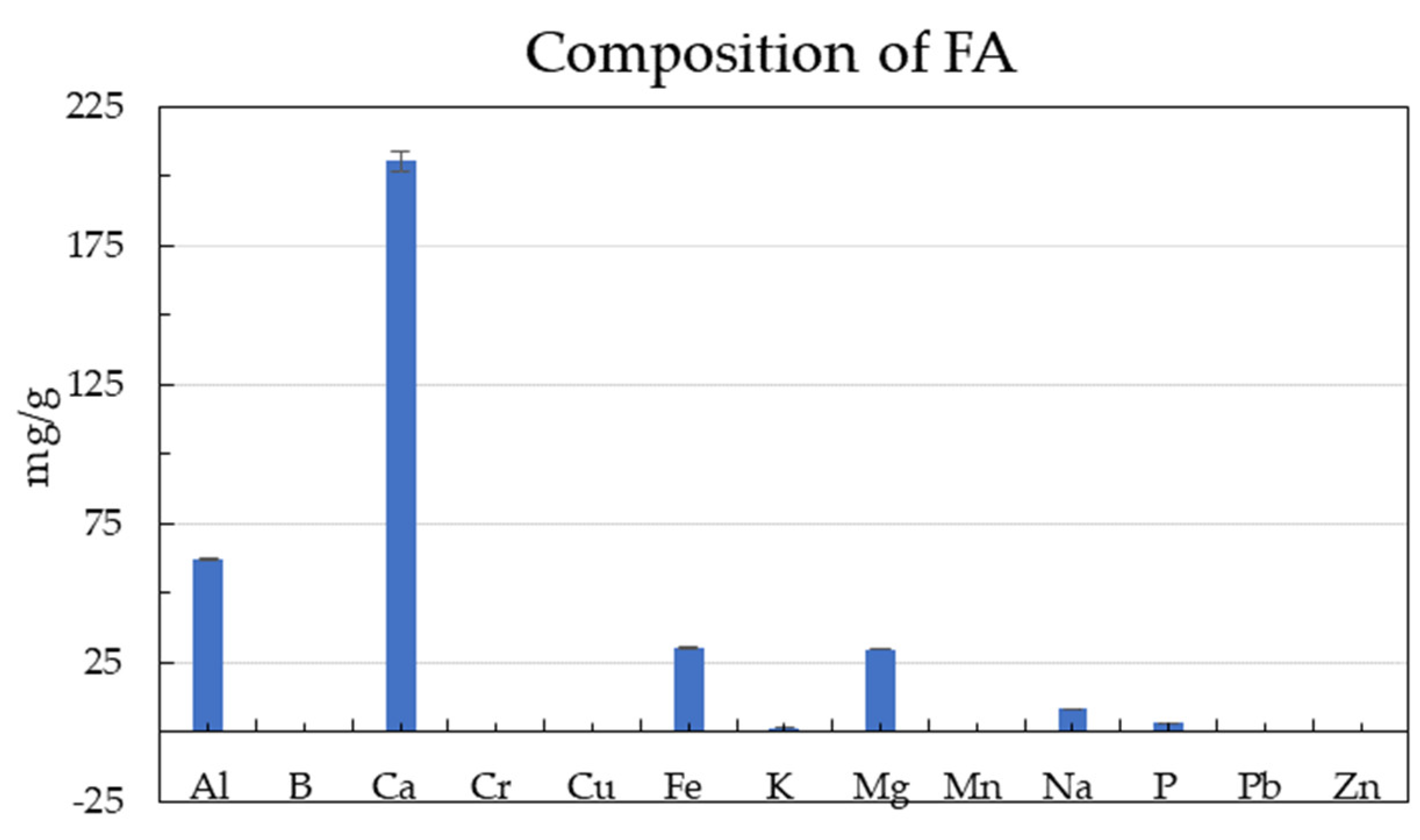
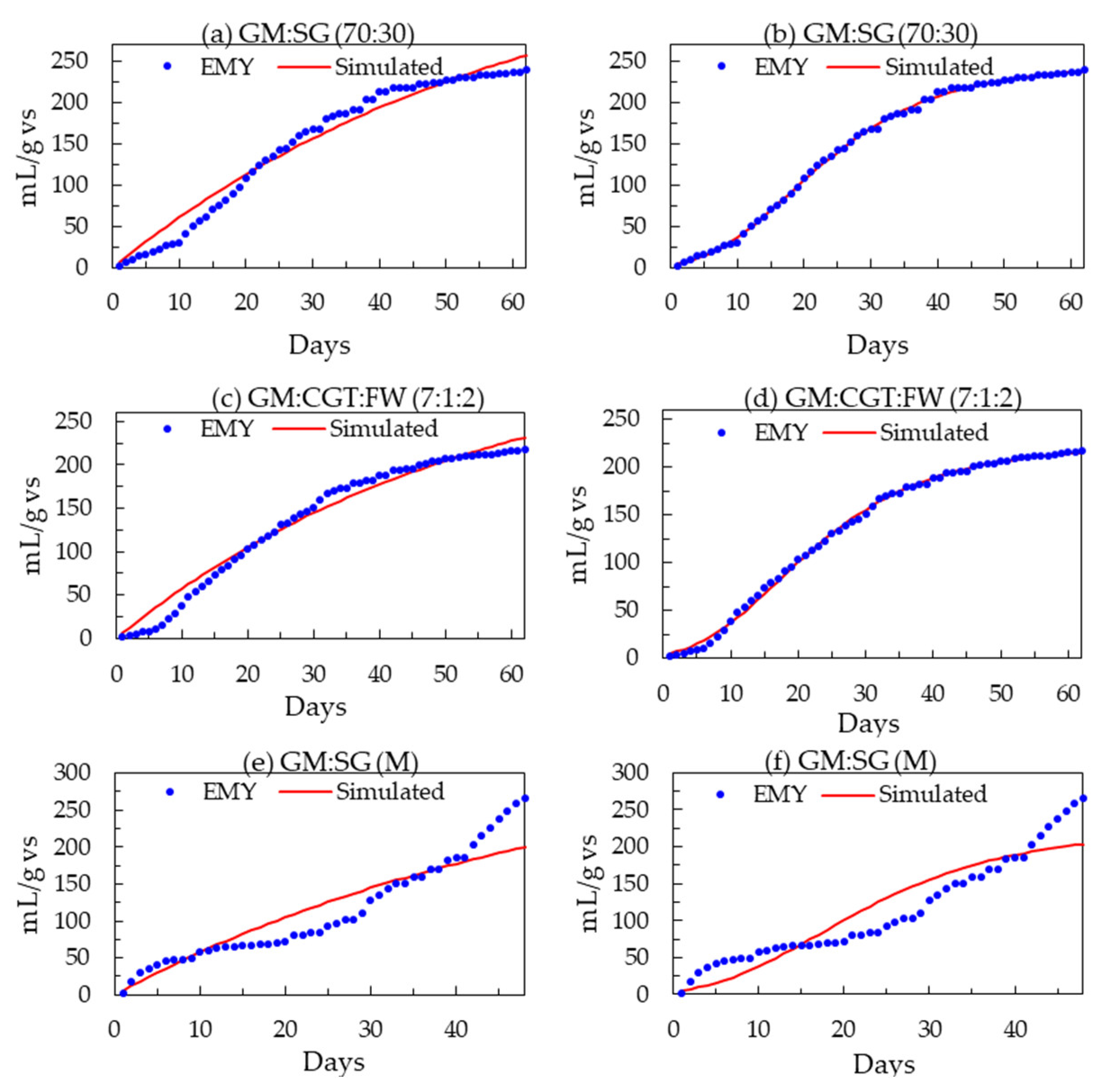
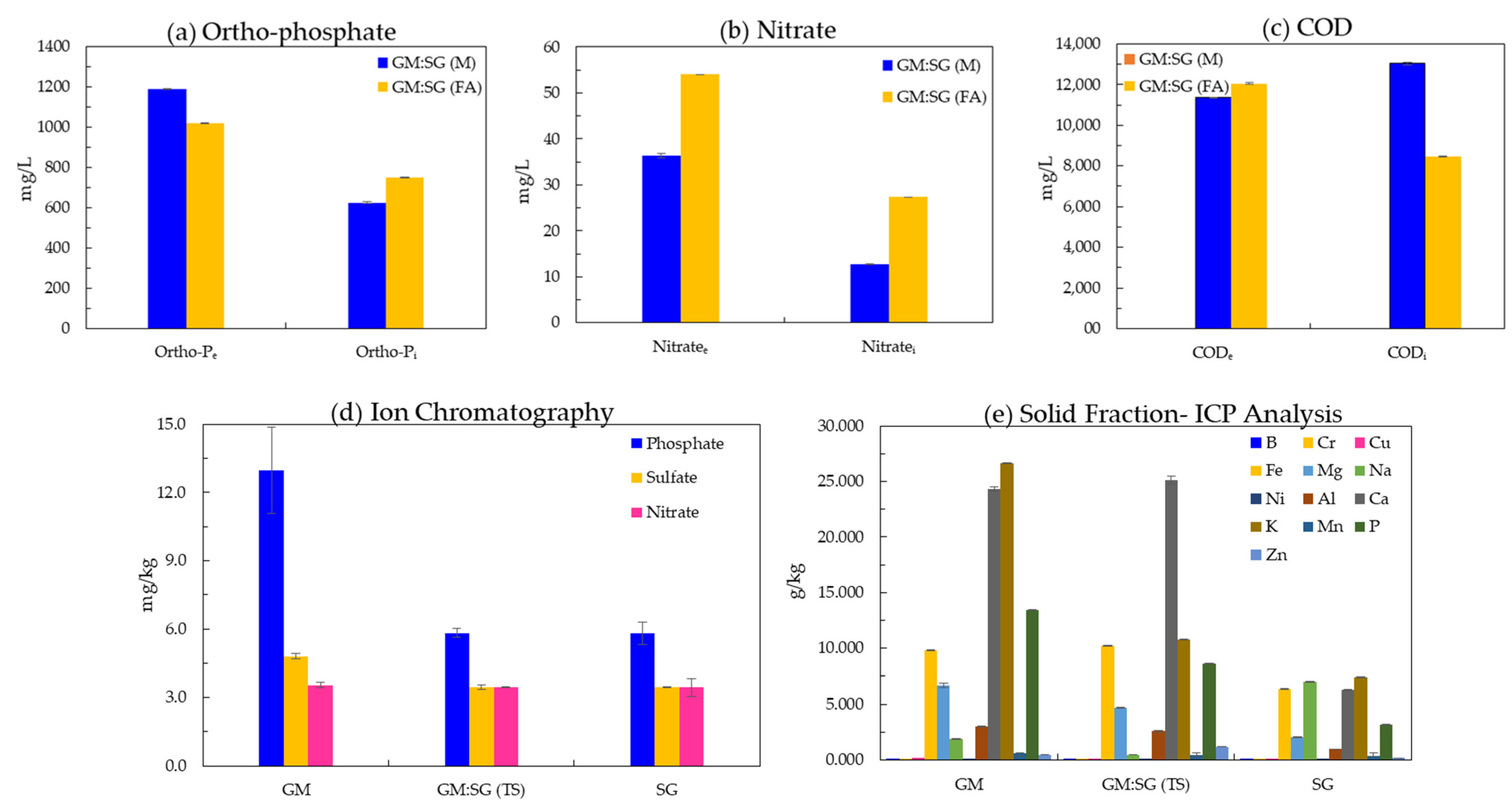
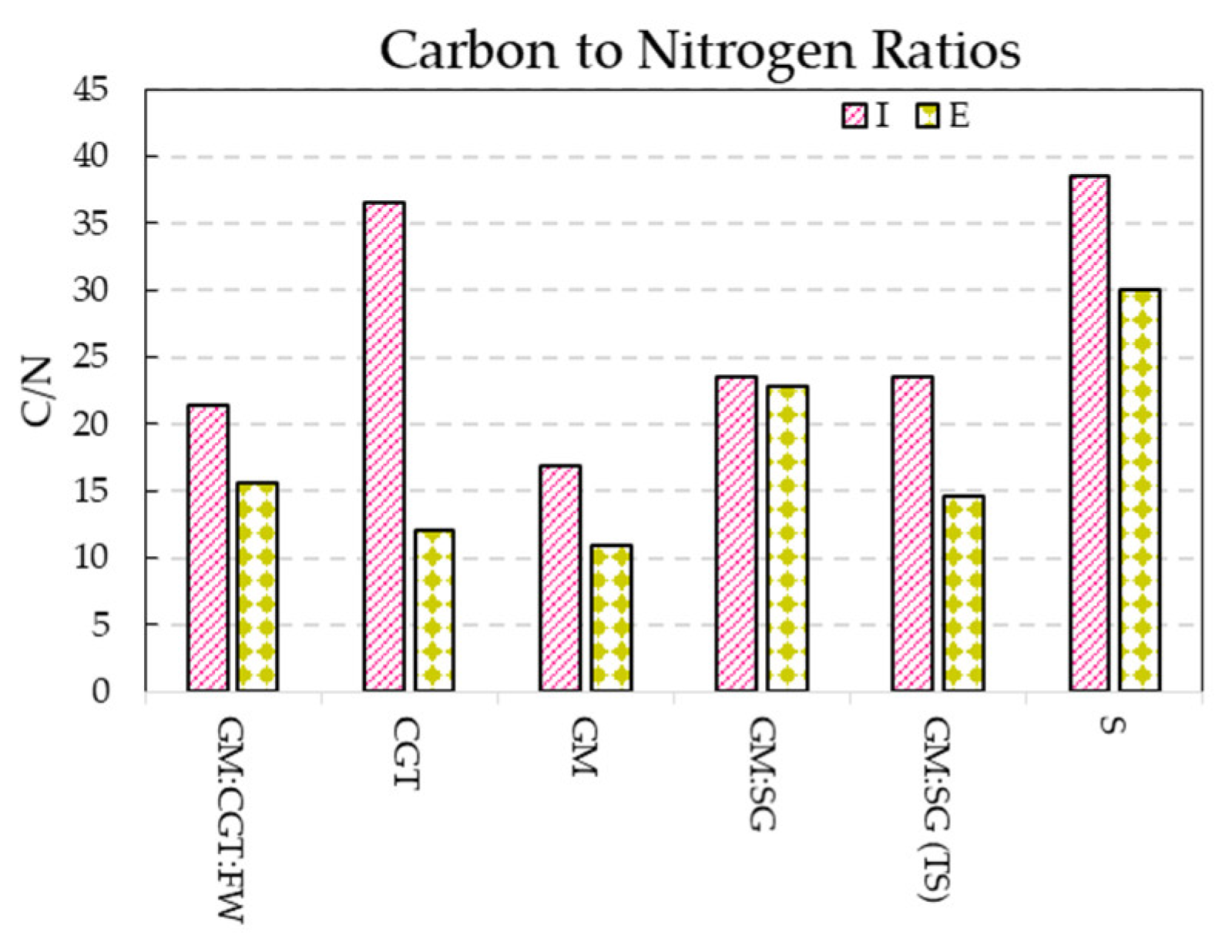
| Parameter | GM:SG | GM:CGT:FW | GM:SG (TS) |
|---|---|---|---|
| Digester volume (mL) | 250 | 250 | 2000 |
| Working volume (mL) | 100 | 100 | 800 |
| OLR a (%Total solids) | 10 | 10 | 10 |
| BMP Duration (d) b | 62 | 62 | 48 |
| Gas measurement | Liquid displacement | - | - |
| Headspace (mL) | 150 | 150 | 1200 |
| Buffer | Bicarbonate | Bicarbonate | - |
| Data (STP) | mL/gvs | mL/gvs | mL/gvs |
| Parameter | GM | SG | CGT | FW | Inoculum |
|---|---|---|---|---|---|
| Moisture (%) | 6.7 ± 0.1 | 10.5 ± 0.3 | 12.0 ± 0 | 15.9 ± 0.2 | 98.0 ± 0.1 |
| TS a (%) | 93.3 ± 0.1 | 89.5 ± 0.3 | 87.7 ± 0.4 | 84.1 ± 0.2 | 2.0 ± 0.1 |
| VS b (%) | 71.5 ± 0.2 | 83.2 ± 0.2 | 78.9 ± 0.8 | 80.8 ± 0.4 | 2.2 ± 0.2 |
| Ash (%) | 20.0 ± 0 | 6.5 ± 0 | 9.3 ± 0 | 3.4 ± 0.1 | 0 |
| N (%-TS) | 2.4 ± 0.3 | 1.2 ± 0.1 | 1.3 ± 0 | 2.2 ± 0.1 | - |
| C (%-TS) | 41.0 ± 0.5 | 46.2 ± 0.2 | 47.3 ± 1.2 | 46.5 ± 0.5 | - |
| H (%-TS) | 6.4 ± 0.2 | 6.6 ± 0.1 | 4.5 ± 0 | 0 | - |
| O (%-TS) | 49.8 ± 0.6 | 45.8 ± 0.3 | 46.6 ± 1.5 | 51.2 ± 0 | - |
| S (%-TS) | 0.4 ± 0 | 0.2 ± 0 | 0.2 ± 0 | 0.2 ± 0 | - |
| C/N | 17.0 ± 2.5 | 38.5 ± 1.8 | 36.3 ± 0.9 | 21.2 ± 1.1 | - |
| Elemental Formula | C341.9H639.967O311.5N16.8S1.2 | C385.1H659.9O286.1N8.7S0.6 | C390.0H450.0O290.8N21.2S0.6 | C3.2H0O3.2N1.6S0.06 | - |
| TMY c (mL/gvs) | 372.9 | 448.2 | 451.0 | 305.4 | - |
| Alkalinity d (mg/L) | 973.0 ± 32.5 | 509.0 ± 0 | 1642.5 ± 99.7 | 70.3 ± 1.8 |
| Co-Digestion | TMY a (mL/gvs) | EMY b (mL/gvs) | BD c (%) |
|---|---|---|---|
| GM:SG | |||
| 100:0 | 372.9 | 218.1 ± 14.2 | 58.5 |
| 70:30 | 395.6 | 239.3 ± 15.6 | 60.5 |
| GM:CGT:FW | |||
| 100:0:0 | 372.9 | 224.7 ± 19.9 | 60.3 |
| 70:10:20 | 367.2 | 217.6 ± 5.4 | 59.3 |
| GM:SG (TS) d | |||
| Anaerobic Medium (M) | 395.6 | 266.0 | 67.3 |
| Fly Ash (FA) | 395.6 | 149.8 | 37.9 |
Disclaimer/Publisher’s Note: The statements, opinions and data contained in all publications are solely those of the individual author(s) and contributor(s) and not of MDPI and/or the editor(s). MDPI and/or the editor(s) disclaim responsibility for any injury to people or property resulting from any ideas, methods, instructions or products referred to in the content. |
© 2023 by the authors. Licensee MDPI, Basel, Switzerland. This article is an open access article distributed under the terms and conditions of the Creative Commons Attribution (CC BY) license (https://creativecommons.org/licenses/by/4.0/).
Share and Cite
Kaur, H.; Kommalapati, R.R. Process Optimization and Biomethane Recovery from Anaerobic Digestion of Agro-Industry Wastes. Energies 2023, 16, 6484. https://doi.org/10.3390/en16186484
Kaur H, Kommalapati RR. Process Optimization and Biomethane Recovery from Anaerobic Digestion of Agro-Industry Wastes. Energies. 2023; 16(18):6484. https://doi.org/10.3390/en16186484
Chicago/Turabian StyleKaur, Harjinder, and Raghava R. Kommalapati. 2023. "Process Optimization and Biomethane Recovery from Anaerobic Digestion of Agro-Industry Wastes" Energies 16, no. 18: 6484. https://doi.org/10.3390/en16186484
APA StyleKaur, H., & Kommalapati, R. R. (2023). Process Optimization and Biomethane Recovery from Anaerobic Digestion of Agro-Industry Wastes. Energies, 16(18), 6484. https://doi.org/10.3390/en16186484






